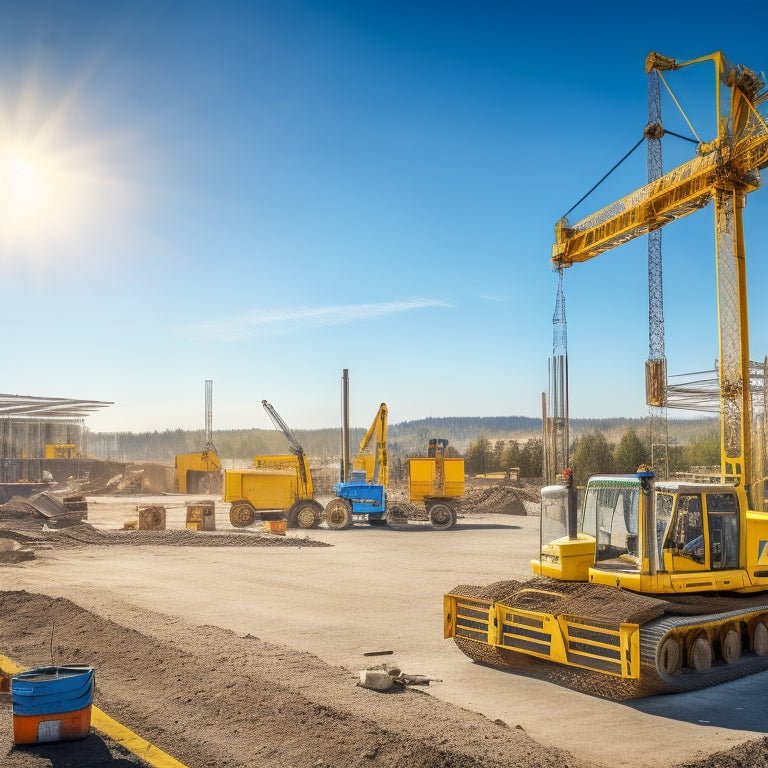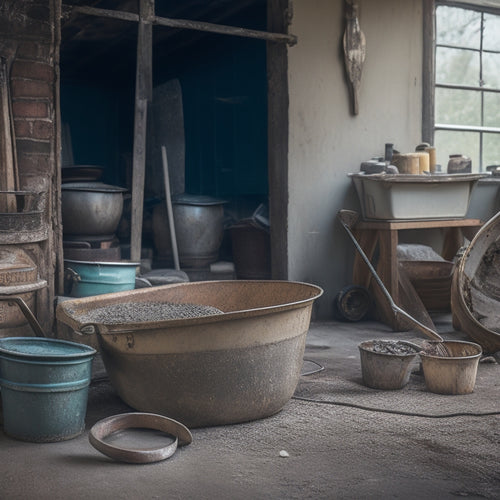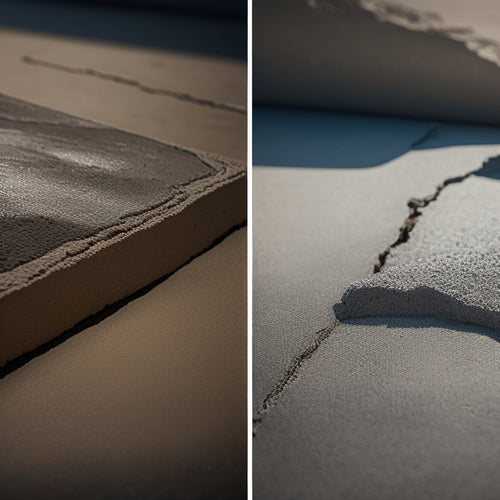
Top Safety Tools for Concrete Building Projects
Share
When working on concrete building projects, you need the right safety tools to protect yourself from serious injuries. Hard hats with durable shells, suspension systems, and chin straps are vital for head protection. Steel-toed boots with slip-resistant soles and ankle support prevent foot injuries. High-visibility safety vests, reinforced gloves, and safety goggles provide added protection. Fall protection harness systems, lanyards, and concrete dust respirators are also essential. Additionally, having first aid kits on-site can help respond to emergencies quickly. By investing in these top safety tools, you'll be better equipped to mitigate risks and guarantee a safer work environment - and exploring each of these tools in more detail can help you further minimize hazards on your project site.
Key Takeaways
- Hard hats, steel-toed boots, high-visibility vests, reinforced gloves, and safety goggles are essential personal protective equipment for concrete building projects.
- Fall protection equipment, including harness systems and lanyards, is critical for elevated work to prevent falls and injuries.
- Respiratory protection, such as concrete dust respirators, is necessary to filter out airborne particles and prevent respiratory issues.
- Eye protection, including goggles with impact-resistant lenses, is vital to prevent eye injuries from flying particles, chemical splashes, and heavy objects.
- First aid kits and emergency preparedness plans, including on-site training and clear protocols, are crucial for responding to accidents and injuries on site.
Essential Hard Hat Protection
When you step onto a concrete building project site, a hard hat is the first line of defense against falling objects, debris, and other hazards that can strike your head.
It's vital to choose a hard hat that meets the required hard hat standards, such as those set by the Occupational Safety and Health Administration (OSHA) and the American National Standards Institute (ANSI).
Look for hard hats with features like a durable shell, a suspension system to absorb impacts, and a chin strap to secure the hat in place.
Additionally, consider hard hats with enhanced features like ventilation systems, integrated visors, or built-in communication devices.
Confirm your hard hat is certified to meet the ANSI Z89.1 standard, which specifies requirements for industrial head protection.
Don't compromise on your safety - always wear a hard hat that meets the required standards and features to protect yourself from potential head injuries.
Steel-Toed Boots for Concrete
Your hard hat is securely fastened, now it's time to guarantee your feet are protected from the hazards that come with working on a concrete building project. Steel-toed boots are an essential component of your personal protective equipment (PPE) arsenal. They provide a barrier between your feet and heavy objects, sharp edges, and other hazards that can cause injury.
The benefits of steel-toed boots are numerous. They protect your toes from crushing injuries, provide slip-resistant soles, and offer ankle support. Additionally, they meet stringent footwear regulations, ensuring you're compliant with industry standards.
Here's a breakdown of the key features to look for in steel-toed boots:
| Feature | Description | Regulation |
|---|---|---|
| Steel Toe | Protects toes from crushing injuries | OSHA 29 CFR 1910.136 |
| Slip-Resistant Sole | Prevents slipping on smooth surfaces | ANSI/ASTM F2413-18a |
| Ankle Support | Provides stability and protection | CSA Z195-14 |
When selecting steel-toed boots, make sure they meet the relevant regulations and standards for your concrete building project. Remember, your safety is paramount, and the right footwear can make all the difference.
High-Visibility Safety Vests
High-visibility safety vests are an essential component of your personal protective equipment (PPE) on a concrete building project.
You'll need a vest that meets the required visibility standards, ensuring you're seen by coworkers, equipment operators, and other personnel on site. Look for vests that meet ANSI/ISEA 107-2015 standards, which specify requirements for high-visibility safety apparel.
When selecting a vest, consider the materials used.
You'll want a vest made from durable, breathable materials that can withstand the demands of a concrete building project. Polyester or nylon mesh vests are popular choices, as they provide excellent visibility while allowing for airflow and moisture wicking.
Additionally, some vests feature reflective strips or fluorescent colors to enhance visibility in low-light conditions.
Reinforced Gloves for Grip
When working on concrete building projects, you need gloves that provide more than just basic protection.
Reinforced gloves for grip enhance your grip strength, allowing you to better grasp tools and materials, while also protecting your hands from abrasion.
Grip Strength Enhancement
Concrete construction projects often require workers to handle heavy, unwieldy materials, which can put immense strain on their hands and fingers.
As you work on these projects, it's crucial to prioritize grip strength enhancement to prevent injuries and improve overall job performance.
You can incorporate grip training into your daily routine through various strength exercises. These exercises will help you develop the necessary grip strength to handle heavy materials with confidence.
Here are some exercises to get you started:
- Squeeze a small rubber ball or hand grip for 5-10 seconds, release, and repeat for 10-15 reps.
- Use a grip strengthener or grip trainer to perform exercises like wrist curls and extensions.
- Practice finger bends by placing a light weight or resistance band around your fingers and bending them down toward your palm.
- Perform forearm curls using dumbbells or a barbell to target the muscles in your forearms.
- Engage in activities that require grip strength, such as rock climbing or rowing, to build functional strength.
Protection From Abrasion
You've developed the grip strength needed to handle heavy materials, but now it's time to protect your hands from the abrasive nature of concrete and other building materials. Reinforced gloves with abrasion resistant materials are a must-have for concrete building projects.
These gloves feature palm and finger surfaces made with durable materials that can withstand the rough texture of concrete, preventing skin irritation and injuries. Surface treatment methods, such as coatings or laminations, can further enhance the abrasion resistance of these gloves.
Look for gloves with reinforced palms and fingers, as well as wrist cuffs that provide additional protection from debris and dust. The right pair of gloves won't only protect your hands from abrasion but also provide the grip and dexterity you need to get the job done efficiently.
When selecting reinforced gloves, consider the level of abrasion resistance you need based on the specific materials you'll be working with. Choose gloves that meet or exceed industry standards for abrasion resistance, and make sure they fit comfortably to prevent fatigue and discomfort during extended wear.
Impact Resistance Boost
Most concrete building projects involve handling heavy materials, which can lead to impact injuries if not handled properly. To mitigate this risk, it's crucial to wear reinforced gloves that provide an impact resistance enhancement.
These gloves are designed to absorb and distribute impact forces, reducing the likelihood of injury to your hands.
When selecting reinforced gloves, consider the following factors:
-
Impact testing: Look for gloves that have undergone rigorous impact testing to guarantee they can withstand the forces involved in concrete building projects.
-
Material selection: Choose gloves made from high-quality, impact-resistant materials that can absorb and distribute forces effectively.
-
Grip pattern: A textured grip pattern can help improve your grip on heavy materials, reducing the likelihood of drops and accidents.
-
Fit and comfort: Select gloves that fit comfortably and allow for a full range of motion, reducing fatigue and improving dexterity.
-
Certifications: Confirm the gloves meet or exceed relevant industry standards and certifications, such as ANSI or EN standards.
Fall Protection Harness Systems
Fall Protection Safety Systems
Three fundamental components make up a fall protection safety system: the anchorage connector, the body harness, and the connector. As you prepare for your concrete building project, it's essential to understand the importance of each component and how they work together to keep you safe.
You'll need to guarantee a proper fit of the body harness, which should be snug but not constricting. Make sure to adjust it according to the manufacturer's instructions to prevent shifting during a fall.
Regular harness maintenance is also significant to prevent wear and tear. Inspect your harness before each use, looking for signs of damage, fraying, or corrosion.
When selecting a fall protection harness system, consider the type of work you'll be doing and the environment you'll be in. Will you be working at heights, or in confined spaces?
Choose a system that's specifically designed for your needs, and always follow the manufacturer's guidelines for use and maintenance. By doing so, you'll be well-protected in the event of a fall and can focus on getting the job done safely and efficiently.
Concrete Dust Respirators Needed
Every concrete building project generates massive amounts of dust, which can be hazardous to your health if inhaled.
You're at risk of respiratory hazards, including chronic lung diseases like silicosis, when you breathe in concrete dust without proper protection. To mitigate this risk, you need concrete dust respirators that filter out 99.97% of airborne particles as small as 0.3 microns.
When selecting a respirator, consider the following factors:
-
Filter type: Choose a respirator with a HEPA (High Efficiency Particulate Air) filter or a filter with similar efficiency.
-
Fit testing: Verify the respirator fits snugly on your face to prevent air leaks.
-
Usage duration: Select a respirator with an adequate usage duration to minimize the need for frequent replacements.
-
Maintenance: Choose a respirator with easy-to-clean and replaceable parts.
-
Certifications: Look for respirators certified by reputable organizations, such as NIOSH or CE, to ascertain compliance with safety standards.
Safety Goggles for Debris
When you're working on a concrete building project, you're constantly at risk of eye injuries from flying debris.
Debris can come in many forms, from small rocks and pebbles to sharp metal fragments, and can cause serious harm if you're not properly protected.
Protecting Eyes From Debris
Many construction sites generate a staggering amount of debris, posing a significant threat to your eyes. As you work on a concrete building project, it's crucial to prioritize eye safety to avoid debris hazards.
Failing to do so can result in serious eye injuries, including corneal abrasions, retinal detachments, and even blindness.
To protect your eyes from debris, you should:
- Wear safety goggles that meet the American National Standards Institute (ANSI) Z87.1+ standard for impact resistance
- Make certain your goggles have a snug, comfortable fit to prevent debris from entering
- Choose goggles with anti-fog coatings to maintain clear vision
- Consider goggles with prescription lenses if you wear corrective eyewear
- Regularly clean and maintain your goggles to guarantee peak performance
Debris Types and Risks
You're likely to encounter various types of debris on a concrete building project, each posing unique risks to your eyes. It is vital to understand the different types of debris and their associated risks to guarantee you take the necessary precautions to protect your eyes.
| Debris Type | Risk Assessment |
|---|---|
| Flying particles (e.g., cement, aggregate) | High risk of eye penetration and scratching |
| Chemical splashes (e.g., acid, alkaline) | High risk of eye irritation and burns |
| Heavy objects (e.g., tools, materials) | High risk of eye trauma and blunt force injury |
| Sharp objects (e.g., rebar, metal scraps) | High risk of eye laceration and puncture |
| Dust and fine particles | Moderate risk of eye irritation and respiratory issues |
Debris classification is critical in risk assessment, as it helps identify the level of protection required. By understanding the types of debris you're likely to encounter, you can select the appropriate safety goggles to mitigate the risks. This guarantees you're adequately protected and can focus on completing your concrete building project safely and efficiently.
GoggleLens Material Matters
Five key lens materials are commonly used in safety goggles designed to protect against debris on concrete building projects.
When choosing the right goggles for your project, it's crucial to evaluate the lens material to guarantee maximum protection and comfort.
-
Polycarbonate: Lightweight, impact-resistant, and affordable, polycarbonate lenses are a popular choice for debris protection. They provide excellent optical clarity and are often used in general-purpose safety goggles.
-
Trivex: Similar to polycarbonate, Trivex lenses offer superior impact resistance and optical quality. They're also lightweight and comfortable to wear, making them ideal for extended wear.
-
NXT: NXT lenses combine the benefits of polycarbonate and Trivex, offering exceptional impact resistance, optical clarity, and comfort. They're a great choice for high-risk debris environments.
-
Glass: Glass lenses provide superior optical quality and scratch resistance, but they're heavier and more expensive than other materials. They're often used in specialty goggles for specific tasks.
-
Acrylic: Acrylic lenses are the most affordable option, but they're also the most prone to scratches and damage. They're typically used in economy-grade safety goggles for low-risk debris environments.
When selecting safety goggles, evaluate the goggle lens types and goggle comfort fit to guarantee you get the right protection for your concrete building project.
First Aid Kits On-Site
How prepared are you to respond to accidents on your concrete building project site? Having a well-stocked first aid kit on-site is vital in providing immediate care to injured workers. It's important to make certain that your kit includes first aid essentials such as bandages, antiseptic wipes, and pain relievers.
However, having a first aid kit is only half the battle. You must also provide on-site training to your workers on how to properly use the kit's contents. This training should cover basic first aid techniques, such as wound cleaning and dressing, as well as what to do in case of more severe injuries like broken bones or head trauma.
Make sure your first aid kit is easily accessible and regularly inspected to guarantee everything is up-to-date and not expired. You should also have a clear protocol in place for reporting and responding to accidents, including a system for calling emergency services if needed.
Lanyards for Elevated Work
Safety at heights is a delicate balance, where one misstep can have devastating consequences. When you're working on a concrete building project, it's essential to have the right safety tools to prevent falls and guarantee your team's well-being. Lanyards are a critical part of your fall protection gear, providing a secure connection between you and the anchor point.
You'll need to choose the right lanyard type for your specific task, considering factors like length, material, and shock absorption. Some common lanyard types include:
- Retractable lanyards for flexibility and ease of use
- Web lanyards for durability and resistance to abrasion
- Rope lanyards for added strength and durability
- Shock-absorbing lanyards to reduce the force of a fall
- Adjustable lanyards for a customizable fit
Regular lanyard maintenance is also important to guarantee your gear remains reliable. You should inspect your lanyards before each use, looking for signs of wear, damage, or corrosion.
Make sure to follow the manufacturer's guidelines for cleaning, storing, and replacing your lanyards to prevent accidents and extend their lifespan.
Frequently Asked Questions
How Often Should I Inspect My Fall Protection Harness System?
You should inspect your fall protection safety system regularly, ideally before each use, and at least every 6 months for safety maintenance; consider daily, weekly, and monthly checks to guarantee peak inspection frequency.
Can I Wear Regular Glasses Instead of Safety Goggles?
You shouldn't wear regular glasses instead of safety goggles; they don't provide adequate protection. Consider safety eyewear alternatives, like prescription safety goggles, which meet ANSI standards and offer impact resistance, ensuring your eyes are protected from concrete building project hazards.
Are High-Visibility Safety Vests Required for Nighttime Work?
You're likely aware that 75% of nighttime accidents occur due to poor visibility. When working at night, you're required by safety regulations to wear high-visibility safety vests, ensuring your nighttime visibility and reducing the risk of accidents.
Do I Need a Concrete Dust Respirator for Indoor Projects?
When working indoors with concrete, you'll likely need a respirator to minimize dust exposure. Consider half-face or full-face respirator types, which provide varying levels of protection against airborne particles, ensuring you breathe safely on the job.
Can I Use a First Aid Kit From a Previous Project On-Site?
When you're on a road trip, you don't reuse last year's roadmap; you get an updated one. Similarly, you shouldn't reuse a first aid kit from a previous project on-site; it may not meet current project guidelines, and expired supplies can be as useless as an outdated map.
Conclusion
As you step onto the concrete building site, the cacophony of sounds and whirlwind of activity can be overwhelming. But amidst the chaos, one thing coincides with your every move: safety. Your hard hat shields your head, steel-toed boots protect your feet, and high-visibility vest makes you visible. It's a concert of safety, where every tool works in harmony to guarantee you return home unscathed. With these top safety tools, the rhythm of risk is replaced by the melody of protection.
Related Posts
-

Top Tools for Mixing Concrete at Home
When mixing concrete at home, you'll need a range of tools to guarantee a successful operation. Start with essential ...
-

What Tools Ensure Strong Concrete Adhesion at Home
You'll need the right tools to guarantee strong concrete adhesion at home. For surface preparation, use concrete surf...
-

10 Best Tools for Sealed Concrete Finishing Success
When it comes to sealed concrete finishing success, you need a robust arsenal of specialized tools. Start with essent...


